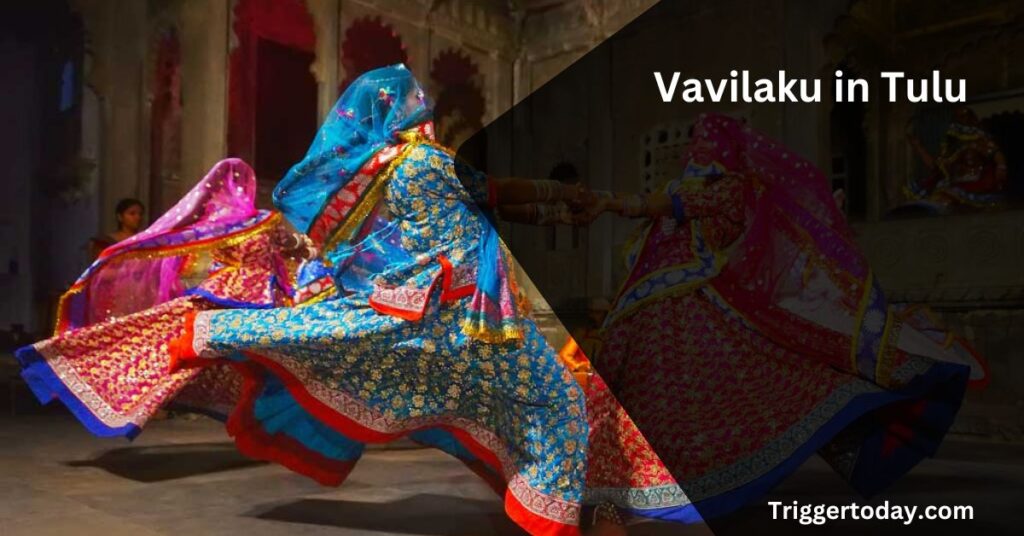Vavilaku in Tulu – An In-Depth Exploration!

“Vavilaku in Tulu” is a term that embodies the rich cultural tapestry of the Tulu-speaking community, predominantly residing in the coastal regions of Karnataka, India. This community, known for its vibrant traditions, rituals, and festivals, has a heritage that reflects deep historical roots and spiritual beliefs.
This article aims to provide a comprehensive and informative exploration of “Vavilaku in Tulu,” offering insights, analyses, and interpretations that go beyond existing information.
The Tulu-speaking Community: An Overview
The Tulu-speaking community, also known as Tuluvas, primarily inhabits the southwestern coastal region of Karnataka, India, known as Tulu Nadu.
This region comprises the districts of Dakshina Kannada and Udupi. The Tulu language is part of the Dravidian language family and has a rich literary tradition. The community is renowned for its unique cultural practices, vibrant festivals, and distinct rituals.
Historical Background
The history of the Tulu-speaking community dates back to ancient times. Tulu Nadu has been mentioned in various historical texts and inscriptions. The region was historically known for its strategic importance and cultural richness. It has seen the influence of various dynasties, including the Kadambas, Alupas, and Vijayanagara Empire, which have contributed to its diverse cultural landscape.
Cultural Heritage of the Tulu Community
The cultural heritage of the Tulu community is a blend of various elements, including folklore, traditional music and dance, rituals, and festivals. The community’s customs are deeply rooted in their spiritual beliefs and historical experiences.
Traditions and Rituals
One of the most distinctive aspects of the Tulu community is their traditional rituals and practices. These rituals are often linked to agricultural cycles, religious beliefs, and local deities. Some of the notable traditions include:
- Bhuta Kola: A traditional ritualistic dance performance dedicated to the worship of local spirits or deities, known as Bhutas. It is characterized by elaborate costumes, vibrant music, and dramatic performances.
- Nagaradhane: The worship of serpent gods, which is prevalent in many Tulu households. Serpent worship is believed to bring prosperity and protect the family from evil spirits.
- Kambala: A traditional buffalo race held in waterlogged paddy fields. It is a popular rural sport and a major attraction during the festive season.
Festivals
The Tulu community celebrates a variety of festivals with great enthusiasm and fervor. These festivals are a reflection of their religious beliefs and cultural heritage. Some of the key festivals include:
- Pili Vesha (Tiger Dance): Performed during the festival of Navaratri, Pili Vesha involves dancers painted like tigers, symbolizing the spirit of the wild. It is a vibrant and energetic performance that captivates audiences.
- Kudla Habba: A local festival that showcases the cultural richness of the Tulu community. It includes folk performances, traditional games, and local cuisine.
- Deepavali: Also known as Diwali, the festival of lights is celebrated with the lighting of oil lamps, bursting of firecrackers, and exchange of sweets and gifts.
Vavilaku in Tulu: Meaning and Significance
“Vavilaku in Tulu” refers to the traditional oil lamps that hold significant cultural and spiritual importance in the Tulu-speaking community. These lamps are not just a source of light but also symbolize knowledge, prosperity, and the dispelling of darkness.
Types of Vavilaku
There are various types of traditional oil lamps used in Tulu households and temples. Some of the common types include:
- Akasha Deepa: A lamp hung high in the air, often during the festival of Deepavali, to ward off evil spirits and bring good fortune.
- Kuthu Vilakku: A tall, standing lamp with multiple wicks, used during auspicious occasions and religious ceremonies.
- Deepastambha: A pillar-like structure with lamps placed on it, commonly found in temples and used during festivals and special rituals.
Rituals Associated with Vavilaku
Lighting the Vavilaku is a ritualistic practice in Tulu culture. It is performed during various occasions, including daily worship, festivals, and special ceremonies. The process of lighting the lamp is often accompanied by chanting of prayers and offering of flowers and incense.
Spiritual Beliefs and Practices
The Tulu community has a rich spiritual tradition, with beliefs and practices that are deeply intertwined with their daily lives. Their spirituality is reflected in their rituals, festivals, and customs.
Bhuta Worship
Bhuta worship is a significant aspect of Tulu spirituality. Bhutas are considered guardian spirits or deities, and their worship involves elaborate rituals, offerings, and dance performances. This practice is believed to ensure the well-being and prosperity of the community.
Serpent Worship
Nagaradhane, or serpent worship, is another important spiritual practice. Serpent gods, known as Nagas, are revered and worshipped for their protective and benevolent qualities. Special rituals are conducted to appease the serpent gods and seek their blessings.
Temple Traditions
Temples play a central role in the spiritual life of the Tulu community. They are not just places of worship but also centers of cultural and social activities. Traditional rituals, festivals, and community gatherings are often held in and around temples.
The Role of Folklore and Oral Traditions
Folklore and oral traditions are an integral part of the cultural heritage of the Tulu community. These traditions include a rich collection of stories, songs, and proverbs that have been passed down through generations.
Folk Stories and Legends
Tulu folklore is replete with stories and legends that reflect the community’s values, beliefs, and historical experiences. These stories often feature mythical creatures, heroic deeds, and moral lessons.
Traditional Songs and Music
Traditional songs, known as Paddanas, are a unique feature of Tulu culture. These songs are sung during various rituals and ceremonies and often narrate stories of gods, heroes, and local legends. The music is usually accompanied by traditional instruments like the Maddale (drum) and Naadaswaram (wind instrument).
Proverbs and Sayings
Tulu proverbs and sayings encapsulate the wisdom and experiences of the community. They are used in everyday conversations and are a reflection of the community’s collective knowledge and values.
The Impact of Modernization on Tulu Culture
Like many other traditional communities, the Tulu-speaking community has also experienced the impact of modernization and globalization. While some aspects of their culture have been preserved, others have undergone changes.
Preservation of Traditions
Efforts have been made by the community to preserve their cultural heritage. Organizations, cultural groups, and individuals have taken initiatives to document and promote Tulu traditions, language, and rituals.
Adaptation to Modern Times
The Tulu community has also adapted to modern times by integrating new practices and technologies into their daily lives. This includes the use of digital media to promote their culture and the incorporation of modern elements into traditional festivals and rituals.
FAQs
What is the significance of “Vavilaku in Tulu”?
“Vavilaku in Tulu” refers to traditional oil lamps used in the Tulu-speaking community. These lamps symbolize knowledge, prosperity, and the dispelling of darkness. They hold significant cultural and spiritual importance.
What are some key festivals celebrated by the Tulu community?
Some key festivals celebrated by the Tulu community include Pili Vesha (Tiger Dance), Kudla Habba, and Deepavali (Diwali). These festivals reflect the community’s religious beliefs and cultural heritage.
What is Bhuta Kola?
Bhuta Kola is a traditional ritualistic dance performance dedicated to the worship of local spirits or deities, known as Bhutas. It is characterized by elaborate costumes, vibrant music, and dramatic performances.
How has modernization impacted Tulu culture?
Modernization has brought both preservation and adaptation to Tulu culture. While efforts have been made to preserve traditions, the community has also adapted to modern times by integrating new practices and technologies.
Where is the Tulu-speaking community primarily located?
The Tulu-speaking community primarily inhabits the southwestern coastal region of Karnataka, India, known as Tulu Nadu. This region comprises the districts of Dakshina Kannada and Udupi.
Conclusion
The “Vavilaku in Tulu” is more than just an oil lamp; it is a symbol of the rich cultural heritage and spiritual beliefs of the Tulu-speaking community.
This article has provided an in-depth exploration of the Tulu community’s traditions, rituals, festivals, and spiritual practices, offering insights and analyses that go beyond existing information.
By understanding and appreciating the cultural significance of “Vavilaku in Tulu,” we can gain a deeper appreciation for the diversity and richness of human culture.







